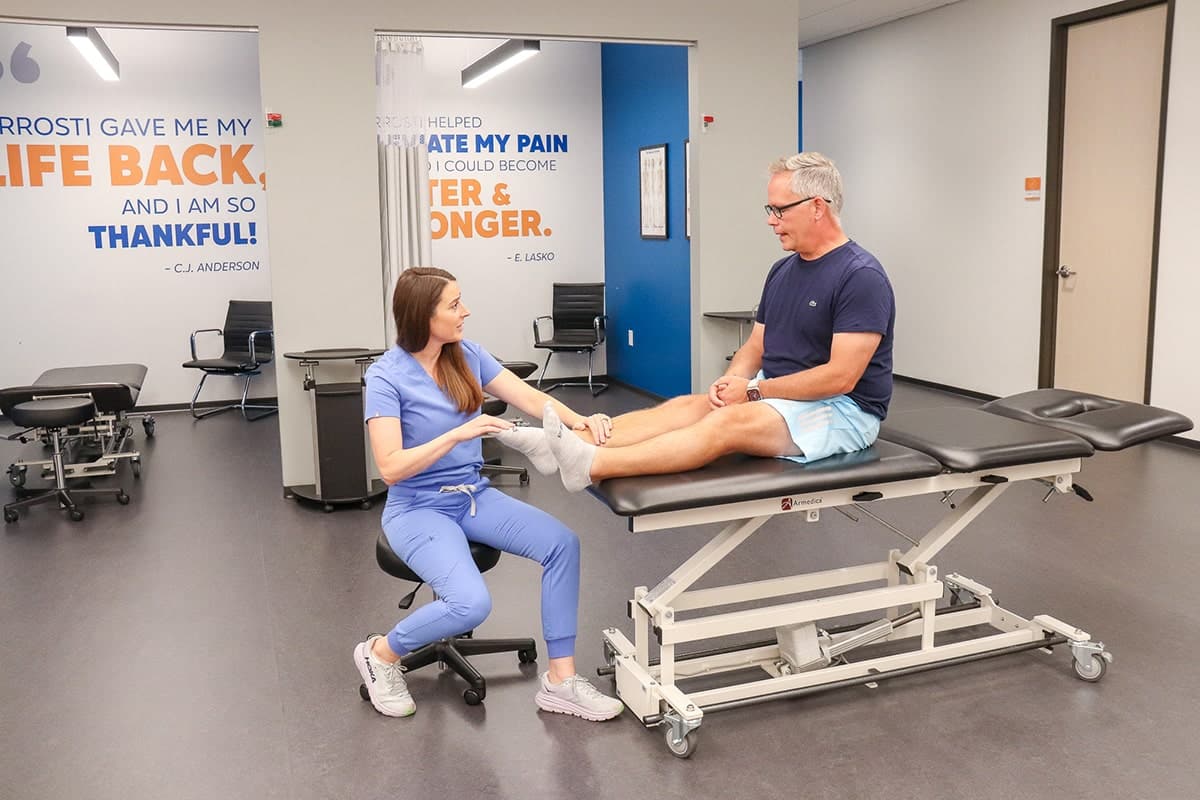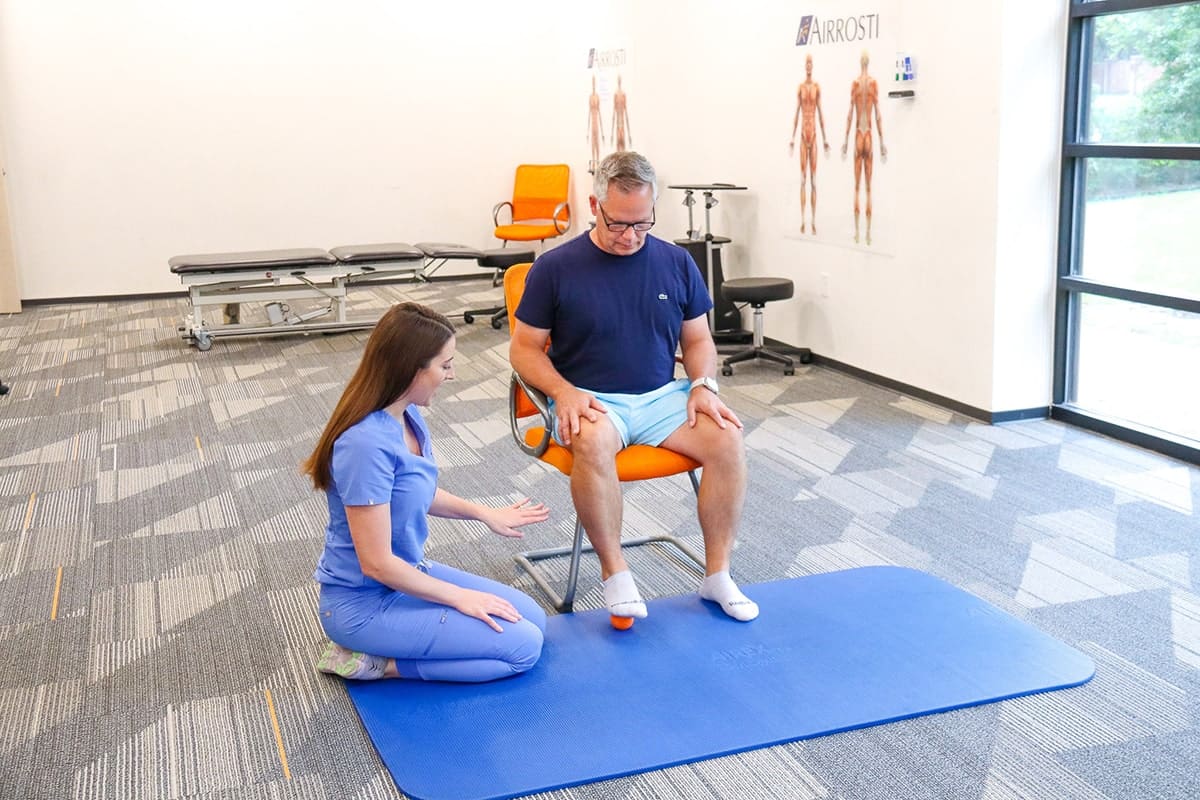(21,000+ reviews on Google across 150+ locations)

Have questions or would like to schedule over the phone? Call us at 844-719-5079
Find an Airrosti Clinic Near You (OH, TX, VA, WA)
We take the time needed for a thorough examination to find the underlying cause of your pain.
Airrosti Providers use hands-on manual therapy to treat your Plantar Fasciitis to reduce pain, increase mobility, and accelerate healing.
No surgery, injections, or prescription medication.
Patients have shorter recovery time with an average of 3.2 visits over 2 weeks.
Speed your recovery and keep your pain from returning.


The plantar fascia is a thick band of tissue that stretches from the heel bone to the ball of the foot. This strong, tight ligament supports the arch of the foot during movement. It also contributes to the body’s gait and distribution of weight.
Because the plantar fascia is used for everyday movements, it is vulnerable to overuse and strain. Wear and tear and improper foot care can lead to a painful overuse injury called plantar fasciitis. This condition is often described as a stabbing or burning sensation in the heel or bottom of your foot.
In this video, Breanne Kelley, DC, discusses the causes, symptoms, and available treatment options for plantar fasciitis. She also explains how Airrosti treats plantar fasciitis and how we help you stay active during treatment.
Still have questions or concerns about your plantar fasciitis? Schedule a no-cost video chat with one of our Providers.
Plantar fasciitis is commonly caused by weak ankle or hip joints. These weak joints put excessive pressure on the feet, leading to inflammation and foot pain. Understanding the causes and risk factors associated with this condition can help in its prevention and management.
Several common risk factors can contribute to the development of plantar fasciitis, including:
People with high arches are more likely to get plantar fasciitis because of the extra pressure on the plantar fascia.
Footwear lacking adequate arch support can fail to provide the necessary cushioning and stability for your feet.
Rapidly increasing the intensity or duration of physical activities, such as running or dancing, can strain the plantar fascia, leading to inflammation and pain.
Sports or occupations that involve repetitive stress on the feet, such as running or jobs that require prolonged walking or standing on hard surfaces.
Furthermore, certain demographic factors can also heighten the likelihood of experiencing plantar fasciitis. People who may have a higher weight, are pregnant or are over 40 tend to be at a higher risk. However, plantar fasciitis can affect people of all ages and lifestyles, regardless of demographic factors.
Plantar fasciitis is characterized by various signs and symptoms that primarily affect the foot’s arch and the bottom of the heel. Chronic heel pain is a common sign of this condition. It may feel like stabbing or burning, especially when you take your first steps in the morning. However, as the day progresses and you engage in physical activity, the pain may subside.
Additionally, there are specific activities that can trigger or exacerbate the heel pain associated with plantar fasciitis. These activities include:
Remaining on your feet for extended durations, such as during work or standing-based activities, can strain the plantar fascia, leading to increased discomfort and pain.
Strenuous exercise like running or jumping can worsen plantar fasciitis symptoms due to the excessive stress it puts on the feet.
After being seated for a while, standing up can trigger a sudden flare-up of pain in the heel.
To effectively manage plantar fasciitis, individuals should recognize signs, be aware of activities that worsen heel pain, and take proactive measures.
Surgery is not usually the first-line treatment for plantar fasciitis. In the majority of cases, conservative treatments such as rest, stretching exercises, orthotic inserts, physical therapy or Airrosti care can effectively manage symptoms and improve the condition. Surgery may be considered as a last resort for severe, persistent cases of plantar fasciitis that do not respond to conservative treatments.
Over-the-counter medications such as nonsteroidal anti-inflammatory drugs (NSAIDs) like ibuprofen or naproxen can help reduce pain and inflammation associated with plantar fasciitis. However, it’s important to use these medications as directed by a healthcare professional and to be aware of potential side effects. Additionally, topical pain relievers or corticosteroid injections may be recommended by a doctor for more severe cases of plantar fasciitis.
Yes, there are several self-care techniques and exercises that can help alleviate plantar fasciitis pain. These may include stretching exercises to loosen the plantar fascia and calf muscles, using orthotic inserts or supportive footwear to reduce strain on the arch of the foot, applying ice to the affected area to reduce inflammation, and avoiding activities that exacerbate symptoms. Additionally, maintaining a healthy weight and practicing good foot hygiene can help prevent and manage plantar fasciitis.
While it’s important to avoid activities that worsen plantar fasciitis symptoms, completely restricting all activity may not be necessary. Low-impact exercises such as swimming or cycling, as well as activities that do not put excessive strain on the feet, can be beneficial for maintaining mobility and promoting healing. However, high-impact activities such as running or jumping should be avoided until symptoms improve. It’s important to listen to your body and avoid overexertion, and to consult with a healthcare professional for personalized guidance on activity modification.
We offer both in-clinic and telehealth appointments to best suit your needs.
Reviewed by Casey Crisp, Doctor of Chiropractic
Disclaimer: Always consult with your doctor before starting any exercise program. If you experience any numbness, tingling or reproduction of your symptoms, please contact your doctor.
